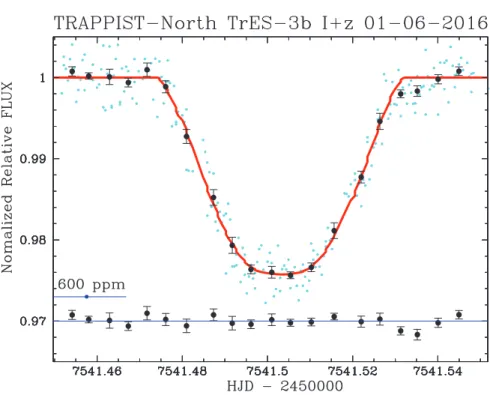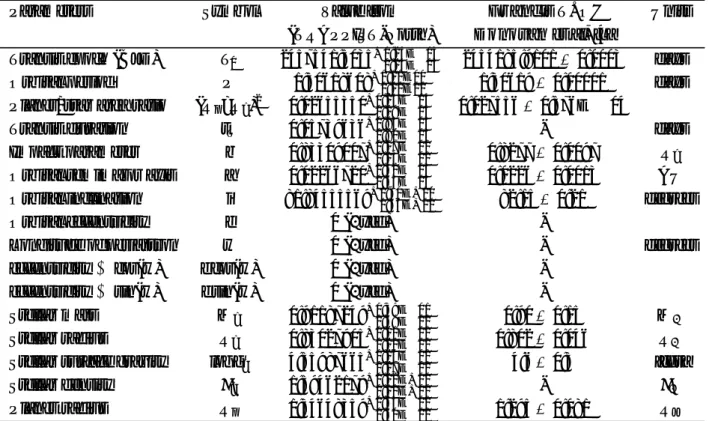Journal of Physics: Conference Series
PAPER • OPEN ACCESS
Assessment of the potential of the new
Belgo-Moroccan telescope TRAPPIST-North for
high-precision exoplanet transit photometry
To cite this article: K Barkaoui et al 2017 J. Phys.: Conf. Ser. 869 012073
View the article online for updates and enhancements.
Related content
Monitoring of comets activity and composition with the TRAPPIST-North telescope
Y Moulane, Z Benkhaldoun, E Jehin et al.
-Scintillation Noise in Exoplanet Transit Photometry
Dóra Föhring, Richard Wilson, James Osborn et al.
-Precision Near-Infrared Photometry for Exoplanet Transit Observations. I. Ensemble Spot Photometry for an All-Sky Survey
C. Clanton, C. Beichman, G. Vasisht et al.
1
Content from this work may be used under the terms of theCreative Commons Attribution 3.0 licence. Any further distribution of this work must maintain attribution to the author(s) and the title of the work, journal citation and DOI.
Published under licence by IOP Publishing Ltd
1234567890
Frontiers in Theoretical and Applied Physics/UAE 2017 (FTAPS 2017) IOP Publishing
IOP Conf. Series: Journal of Physics: Conf. Series 869 (2017) 012073 doi :10.1088/1742-6596/869/1/012073
Assessment of the potential of the new
Belgo-Moroccan telescope TRAPPIST-North for
high-precision exoplanet transit photometry
K Barkaoui1, M Gillon2, Z Benkhaldoun1, J Emmanuel2, T Elhalkouj1, A Daassou1, A Burdanov2, L Delrez2
1
Oukaimeden Observatory, LPHEA, FSSM, Cadi Ayyad University, Morocco
2STAR Institute, University of Liege, Belgium
Abstract. We present the observation of a transit of the exoplanet TrES-3b by the newly commissioned robotic telescope TRAPPIST-North located at Oukaimeden Observatory (Morocco). The obtained light curve reaches a photometric precison 600 ppm. Its Bayesian analysis with a Markov Chain Monte Carlo code enables us to refine the radius of the planet to Rp= 1.346+0.065
−0.050
RJ up. These results demonstrate the high potential of TRAPPIST-North for high-photometry of exoplanet transits.
1. Introduction
When a planet crosses (transits) in front of its parent star’s disk, the observed brightness of the star drops by a small amount whose amplitude depend on the relative sizes of the star and the planet. This method of detection is called transit photometry. The first extrasolar planet observed to transit its star, was HD209458b on 2000, [1]. The radial velocity method provides information about a planet’s mass and the photometric method can determine the planet’s radius. Combined with the radial velocity method, the transit method enables measuring the absolute mass and radius of a planet. The resulting density can than be used to constrain its nature (gas or rocky) and composition.
2. TRAPPIST project
TRAPPIST-North (TRansiting Planets and PlanetesImals Small Telescope [2] and [3]) is a 0.6 m robotic telescope that has started its operation at the Oukaimeden Observatory (Morocco) and done in collaboration with Cadi Ayyad University in June 2016. The project is led by the Origins in Cosmology and Astrophysics (OrCA) group at Liege University in Belgium. TRAPPIST-North and its twin, TRAPPIST-South, in operation in Chile since 2010, are fully dedicated to the study of planetary systems via two complementary approaches: the detection and characterization of transiting exoplanets, and the study of comets and other small bodies in the Solar System. The telescope is fully automated and is protected by a 4.2 meters diameter dome with weather station.
2
1234567890
Frontiers in Theoretical and Applied Physics/UAE 2017 (FTAPS 2017) IOP Publishing
IOP Conf. Series: Journal of Physics: Conf. Series 869 (2017) 012073 doi :10.1088/1742-6596/869/1/012073
3. Observations, data reduction and analysis 3.1. The transit of TrES-3b
The observations, lasted for almost 3 hours on 01/06/2016, starting ∼ 1 hour before ingress and ending ∼ 1 hour after egress. TrES-3 (1SWASPJ175207.01+373246.3) has a I-magnitude = 11.02 and we used an exposure time of 13 seconds in the′
I + z′
filter, in the very-near infrared (roughtly 0.9µm).
Figure 1. Top: Transit of TrES-3b observed on 01 June 2016 by TRAPPIST-North in the ”I + z” filter, together with the best-fit transit model (red line). The normalized differential light curve (green points=unbinned, black points=binned in 7.2 min bins). Bottom : residuals. Their standard deviation is 600 ppm.
The data reduction is thus performed on-site, on dedicated computers installed in TRAPPIST-North’s control room at Oukaimeden, and only some reduction products trans-ferred to Marrakech for interactive final steps. All TRAPPIST-North images are reduced by a semiautomatic pipeline developed in Pyraf. To measure the stellar flux, the pipeline use the aperture photometry task phot of IRAF/DAOPHOT on the aligned science images. For each image, the coordinates of each star are refined by fitting 1D Gaussian functions in x and y on a region of a few pixels centered on the star’s initial coordinates. The stellar fluxes are then extracted for eight different fixed apertures (multiples of the mean FWHM of the PSF over all images of the scientific sequence) centered on these refined coordinates, we used an estimate of the sky background near the star. This value is calculated from the median of pixels in the annular ring. We use the comparison stars to correct the atmospheric effect: the flux of the target star is divided by the sum of the fluxes of stable comparison stars Ftarget/PFcompstars (differential photometry).
To analyze the transit light curve, we use the MCMC (Markov-chain Monte Carlo) code developed in Fortran to determine the parameters of a transiting using as input photometric
3
1234567890
Frontiers in Theoretical and Applied Physics/UAE 2017 (FTAPS 2017) IOP Publishing
IOP Conf. Series: Journal of Physics: Conf. Series 869 (2017) 012073 doi :10.1088/1742-6596/869/1/012073
and radial velocity data. MCMC simulations are based on Bayesian inference meaning it is a method of drawing conclusions from data subject to random variations such as observational data using Bayes’ rule. Bayes’ rule is known in statistics to relate the odds for different events before and after conditioning another event. To implement a MCMC algorithm we need as input, a set of model parameters often called jump parameters in the framework of a code algorithm. Here the jump parameters are the transit depth dF , the transit width W , the mid-transit time T0, the modified impact parameter b′ = a
cosip
R⋆ , the limb darkening coefficients for each filter c1
and c2, the modified RV semi amplitude K2 = KP1/3, and the orbital period P .
Table 1. System parameters for TrES-3b.
Parameters Symbol Value from FrancisT. O’ Units
(TRAPPIST-North) Donovanet al, [4]
Transit epoch (BJD) T0 2457541.5035+0−0.24E−03.24E−03 2454185.9101 ± 0.0003 days
Orbital period P 1.30618608+0.00E00
−0.00E00 1.30619 ± 0.00001 days Planet/star area ratio (Rp/R⋆)2 0.02655350+0−0.23E−04.09E−04 0.027556 ± 0.576E − 04
Transit duration tT 0.05739636+0−0.93E−03.92E−03 - days
Impact parameter b 0.83309007+0−0.17E−01.13E−01 0.8277 ± 0.0097 R⋆
Orbital semimajor axis a 0.02266720+0−0.32E−03.33E−03 0.0226 ± 0.0013 AU Orbital inclination i 81.84555569+0−0.30E+00.36E+00 82.15 ± 0.21 degrees
Orbital eccentricity e 0 (fixed)
-Longitude of periastron w 0 (fixed) - degrees
eccentricity × cos(w) e cos(w) 0 (fixed)
-eccentricity × sin(w) e sin(w) 0 (fixed)
-Stellar mass M⋆ 0.91187249+0−0.39E−01.39E−01 0.90 ± 0.15 M⊙
Stellar radius R⋆ 0.83027905+0−0.20E−01.20E−01 0.802 ± 0.046 R⊙
Stellar surface gravity log g⋆ 4.55987665+0−0.26E−01.27E−01 4.6 ± 0.3 [cgs]
Stellar density ρ⋆ 1.59462179+0−0.12E+00.11E+00 - ρ⊙
Planet radius Rp 1.34648359+0−0.65E−01.50E−01 1.295 ± 0.081 RJ
4. conclusion
Our results demonstrate that TRAPPIST-North is able to measure exoplanet transit light curves with excellent photometric precisions. The planet parameters derived from the analysis of light curve are in excellent agreement with previous works.
References
[1] Charbonneau D et al 2000 ApJ 329 L45-L48
[2] Jehin E, Gillon M, Queloz D, Magain P, Manfroid J, Chantry V, Lendl M, Hutsemkers D and Udry S The Messenger 1452-6
[3] Gillon M, Jehin E, Magain P, Chantry V, Hutsemkers D, Manfroid J, Queloz D and Udry S European Physical Journal Web of Conferences 113
[4] T.O’Donovan F et al 2007 ApJ 663 L37-L40 [5] Gillon M et al 2010 A & A 511 A3

